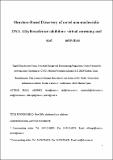Por favor, use este identificador para citar o enlazar a este item:
http://hdl.handle.net/10261/176610COMPARTIR / EXPORTAR:
 SHARE SHARE
 CORE
BASE CORE
BASE
|
|
| Visualizar otros formatos: MARC | Dublin Core | RDF | ORE | MODS | METS | DIDL | DATACITE | |

| Título: | Structure-based discovery of novel non-nucleosidic DNA alkyltransferase inhibitors: virtual screening and in vitro and in vivo activities |
Autor: | Ruiz, Federico M. CSIC ORCID ; Gil-Redondo, Ruben; Morreale, Antonio; Ortiz, Ángel R. CSIC; Fàbrega, Carme CSIC ORCID; Bravo, Jerónimo CSIC ORCID | Palabras clave: | O6-alkylguanine-DNA alkyltransferase (MGMT) Structure-based drug design (SBDD) O6-benzylguanine (O6-BG) 1,3-bis(2-chloroethyl)-1-nitrosourea (BCNU) |
Fecha de publicación: | abr-2008 | Editor: | American Chemical Society | Citación: | Journal of Chemical Information and Modeling 48(4):844-54 (2008) | Resumen: | The human DNA-repair O (6)-alkylguanine DNA alkyltransferase (MGMT or hAGT) protein protects DNA from environmental alkylating agents and also plays an important role in tumor resistance to chemotherapy treatment. Available inhibitors, based on pseudosubstrate analogs, have been shown to induce substantial bone marrow toxicity in vivo. These deficiencies and the important role of MGMT as a resistance mechanism in the treatment of some tumors with dismal prognosis like glioblastoma multiforme, the most common and lethal primary malignant brain tumor, are increasing the attention toward the development of improved MGMT inhibitors. Here, we report the identification for the first time of novel non-nucleosidic MGMT inhibitors by using docking and virtual screening techniques. The discovered compounds are shown to be active in both in vitro and in vivo cellular assays, with activities in the low to medium micromolar range. The chemical structures of these new compounds can be classified into two families according to their chemical architecture. The first family corresponds to quinolinone derivatives, while the second is formed by alkylphenyl-triazolo-pyrimidine derivatives. The predicted inhibitor protein interactions suggest that the inhibitor binding mode mimics the complex between the excised, flipped out damaged base and MGMT. This study opens the door to the development of a new generation of MGMT inhibitors. | Descripción: | 11 páginas, 6 figuras, 2 tablas | Versión del editor: | http://dx.doi.org/10.1021/ci700447r | URI: | http://hdl.handle.net/10261/176610 | DOI: | 10.1021/ci700447r | ISSN: | 1549-9596 | E-ISSN: | 1549-960X |
| Aparece en las colecciones: | (IBV) Artículos |
Ficheros en este ítem:
| Fichero | Descripción | Tamaño | Formato | |
|---|---|---|---|---|
| 2008 J Chem Inf Model 48-844 vers aut.pdf | 352,22 kB | Adobe PDF |  Visualizar/Abrir |
CORE Recommender
SCOPUSTM
Citations
28
checked on 12-abr-2024
WEB OF SCIENCETM
Citations
25
checked on 29-feb-2024
Page view(s)
239
checked on 15-abr-2024
Download(s)
306
checked on 15-abr-2024
Google ScholarTM
Check
Altmetric
Altmetric
NOTA: Los ítems de Digital.CSIC están protegidos por copyright, con todos los derechos reservados, a menos que se indique lo contrario.
